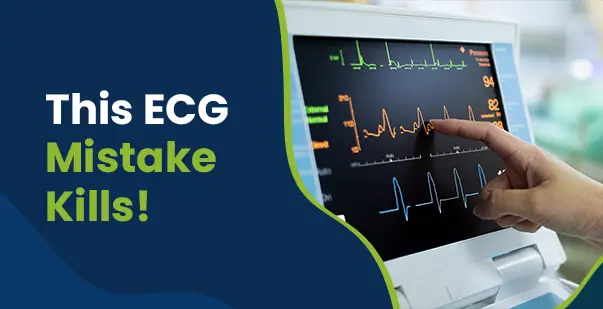When it comes to monitoring heart health, the electrocardiogram (ECG) is one of the most trusted diagnostic tools in medicine. However, despite its reliability, ECG readings can sometimes be disrupted by misleading signals known as ECG artifacts. These artifacts are not caused by the heart itself but rather by external factors such as muscle movement, poor electrode placement, or electrical interference. They can mimic or obscure real cardiac rhythms, which makes interpretation challenging and potentially leads to inaccurate diagnoses. For a medical student, nurse, paramedic, or physician, learning to spot and prevent these artifacts can mean a thin line between clarity and confusion in urgent care situations. So, read on to learn about ECG artifacts, their common types and prevention strategies.
Master ACLS Now
Get ACLS certified with confidence
Common Types of ECG Artifacts
ECG artifacts are disturbances or distortions that may appear on an ECG tracing but don’t usually originate from the heart’s electrical activity. These may happen due to patient movement, equipment issues, or environmental factors. Each type of ECG artifact has unique characteristics that help physicians and healthcare providers identify and manage them. Here’s an overview of the different types of ECG artifacts:
Loose Lead Artifact
You may encounter loose lead artifacts when dealing with diaphoretic patients, who experience excessive sweating because of several conditions like medications or other life events. In this case, the electrodes of an ECG do not stick to the patient’s bodies. You may also see this type of artifact when placing the electrode over the patient’s hair.
Wandering Baseline Artifact
Wandering baseline artifacts usually present as a slow and undulating baseline on the electrocardiogram. These common ECG errors are caused by patient movement, including breathing.
Stopping or improving the ambulance may also cause a wandering baseline ECG. A few others suggest that wandering baseline artifacts happen due to loose or dry electrodes.
Muscle Tremor Artifact
Muscle tremor or tension artifact is often considered a motion artifact. Such ECG waveform abnormalities happen because the patient is cold and shivering. However, they can also happen in cases when patients prop themselves up with their arms.
Electromagnetic Interference (EMI)
Electromagnetic interference (EMI) artifacts usually result from electrical equipment, electrical power lines, and mobile telephones. This is sometimes referred to as 60 cycle interference (or 60 Hz pickup) in the United States.
CPR Compression Artifact
A CPR compression artifact refers to the distortion or interference seen on an electrocardiogram (ECG) during cardiopulmonary resuscitation (CPR) chest compressions. This artifact occurs because the mechanical force of compressions disrupts the normal electrical signals detected by the ECG, making it difficult to interpret heart rhythms accurately.
Neuromodulation Artifact
This specific type of artifact is seen more frequently as implantable neurostimulators become more prevalent in cases of chronic pain management or other neurological conditions. These artifacts can interfere with EEG or other neurophysiological recordings.
Echo Distortion Artifact
This artifact occurs when signals are reflected or delayed within the recording system, leading to repeated or smeared waveforms. It can be caused by improper electrode placement, loose connections, or environmental interferences. It also affects the clarity of neurophysiological recordings.
Arterial Pulse Tapping Artifact
This artifact results from rhythmic pulsations of nearby arteries, often seen in EEG or EMG recordings. It occurs due to mechanical movement transmitted to electrodes, especially when placed over highly vascularized regions. It leads to several rhythmic fluctuations that can mimic physiological signals.
Read More: Can You Perform CPR Without Certification?
Causes of Artifacts in ECG Readings
ECG artifacts are unwanted signals that interfere with the accuracy of cardiac monitoring, often mimicking arrhythmias or obscuring true waveforms. These artifacts can result from patient movement, electrode issues, electrical interference, or even implanted medical devices.
Here are the causes of artifacts in ECG readings:
Muscle Tremors (EMG Artifact)
Involuntary muscle movements, such as shivering, Parkinsonian tremors, or nervous system disorders, can generate high-frequency noise that distorts ECG waveforms. This artifact appears as rapid, irregular baseline fluctuations. This makes it difficult to differentiate from atrial fibrillation or flutter.
Respiratory Movements
Deep or irregular breathing can cause baseline wandering, where the entire ECG waveform shifts up and down rhythmically. This can be mistaken for ischemic ST-segment changes, which makes it challenging to interpret the results accurately.
Body Motion
Patient movement, such as shifting positions, coughing, or talking, can introduce motion artifacts. These artifacts often appear as erratic baseline deviations or sudden spikes by mimicking arrhythmias like ventricular tachycardia.
Poor Electrode Contact
Dry skin, excessive sweating, or body hair can affect electrode adhesion, leading to intermittent signal loss or irregular waveforms. Proper skin preparation, such as cleaning the skin and applying fresh gel-based electrodes, can minimize this issue.
How to Identify and Interpret ECG Artifacts
ECG artifacts can manifest in several ways. They may appear as irregular, rapid spikes that seem completely out of sync with the underlying heart rhythm. They can also present as a baseline wiggle or sway, which can be mistaken for actual heart rhythms.
That is why healthcare providers and other first-time responders must know how to identify ECG artifacts to detect these issues. Here’s how you can interpret them:
Observe Baseline Stability
Artifacts often cause the ECG baseline to shift or fluctuate abnormally. If the baseline appears to move up and down (baseline wander), it may be due to patient movement, deep breathing, or poor electrode contact. A stable baseline is mandatory for accurate interpretation and troubleshooting ECG artifacts.
Look for Repetitive or Unusual Patterns
True cardiac rhythms follow predictable patterns based on physiological function. If you notice erratic, repetitive, or non-physiological waveforms that do not follow a typical P-QRS-T cycle, they are likely artifacts rather than real arrhythmias.
Compare Leads for Consistency
If an irregular waveform appears in only one or two leads but not across all leads, it is likely an artifact rather than a true cardiac event. Genuine arrhythmias tend to appear consistently across multiple leads.
Check for Sudden, Sharp Spikes or Flattening
Artifacts from electrical interference, muscle tremors, or electrode issues can present as sudden, sharp spikes or brief signal loss (flatlining). These abnormalities often have no corresponding physiological explanation, differentiating them from true ECG abnormalities.
Analyze Patient Movement and Condition
Patient activity such as coughing, shifting, or involuntary tremors can cause artifacts. Observing the patient during the cardiogram recording can help correlate waveform disturbances with motion-related ECG artifacts causes.
Read More: What is the Main Determinant of EtCO2 During CPR?
Techniques to Reduce and Prevent ECG Artifacts
More than 300 ECGs are done in the United States annually in primary care. This involves ensuring the highest quality ECG tests are performed to reduce repetitions or errors. Research indicates that proper electrode placement and skin preparation can reduce ECG artifacts by up to 70%, improving signal quality (source: Journal of Clinical Monitoring and Computing). Learn the top techniques to reduce and prevent ECG artifacts below:
Ensure Proper Skin Preparation
Before placing the electrodes, thoroughly clean the patient’s skin to remove oils, lotions, or sweat that may interfere with electrode adhesion. Using an alcohol wipe or mild abrasive pad can help improve electrode contact, reducing signal noise and baseline wander.
Secure Electrode Placement and Quality
Electrodes should be firmly attached to the correct anatomical locations. Loose or dried-out electrodes can cause intermittent signal disruptions, leading to artifacts. Using fresh electrodes and applying appropriate pressure when attaching them helps maintain a stable connection.
Minimize Patient Movement
Unnecessary motion, such as talking, shivering, or shifting positions, can create motion artifacts. Instruct the patient to remain still and relaxed during the ECG recording. If the patient has involuntary tremors, adjusting lead placement or supporting the limbs can help minimize interference.
Reduce Electrical Interference
Nearby electrical devices and power cables can introduce high-frequency noise (50/60 Hz interference) into the ECG. To prevent this, ensure that ECG machines and leads are positioned away from power sources, fluorescent lights, and electronic equipment.
Impact of Artifacts on ECG Accuracy and Diagnosis
ECG artifacts can significantly affect the accuracy of cardiac assessments. In a study published in the Annals of Translational Medicine, the misinterpretation of ECGs due to artifacts resulted in a 14.3% misdiagnosis rate among residents and a 45% rate with automated ECG systems. Let’s understand their impact to ensure precise patient evaluation.
Misdiagnosis of Cardiac Conditions
Artifacts can mimic serious cardiac arrhythmias such as atrial fibrillation, ventricular tachycardia, or asystole. This can lead to unnecessary alarms, misdiagnosis, and inappropriate treatment. It also includes administration of antiarrhythmic drugs or defibrillation.
Unnecessary Repeat Tests and Delays
Poor-quality ECGs due to artifacts often require repeat recordings, delaying diagnosis and treatment. This increases patient discomfort, wastes resources, and may prolong hospital stays, which affects healthcare efficiency.
Masking of True Cardiac Abnormalities
Baseline wander or muscle tremor artifacts can obscure key findings such as ST-segment elevation, T-wave inversions, or subtle arrhythmias. This may lead to missed diagnoses which delays life-saving interventions in conditions like myocardial infarction or ischemia.
Increased Healthcare Costs
Frequent ECG repetitions, additional testing, and unnecessary treatments due to artifact-related misinterpretations increase healthcare costs. This burden affects both healthcare providers and patients.
Troubleshooting ECG Issues in Clinical Settings
ECG readings diagnose several cardiac conditions, but technical issues and artifacts can compromise accuracy. Identifying and resolving these issues promptly ensures reliable results. Here’s how healthcare professionals can troubleshoot common ECG problems in clinical settings:
Address Lead Placement Errors
Incorrect lead placement is a frequent cause of inaccurate ECG readings. Misplaced leads can lead to axis deviation, P-wave misinterpretation, or inverted waveforms. Always verify lead placement using anatomical landmarks and cross-check with standard ECG lead positioning diagrams.
Minimize Electrical Interference
Nearby electrical devices, such as infusion pumps, ventilators, or mobile phones, can introduce high-frequency noise into ECG recordings. Ensure that the ECG machine is plugged into a dedicated, grounded power outlet and keep other electronic equipment at a safe distance.
Manage Patient Movement and Muscle Artifacts
Muscle tremors or involuntary movements can cause baseline fluctuations and distort waveforms. Encourage the patient to relax, support their arms and legs comfortably, and, if needed, instruct them to hold their breath briefly during recording to minimize motion artifacts.
Identify Poor Electrode Contact
Dry or loose electrodes can lead to intermittent signals or baseline wander. Always clean the patient’s skin with alcohol wipes, shave excessive hair if needed, and ensure electrodes are firmly attached with conductive gel. If an electrode is faulty, replace it immediately.
Ensuring Reliable ECG Readings!
ECG artifacts are common in tests and can affect accurate readings for patients. Healthcare professionals must make sure to use every resort possible to get rid of such artifacts. Key methods include ensuring proper electrode placement, using high-quality equipment, minimizing patient movement, and setting the appropriate filtering settings on ECG machines. Regular calibration and maintenance of equipment is also important. If you’re also in this field, consider enrolling in the advanced cardiovascular life support certification to learn how to act in cardiac emergencies and use tools and tests for diagnosis.
References







